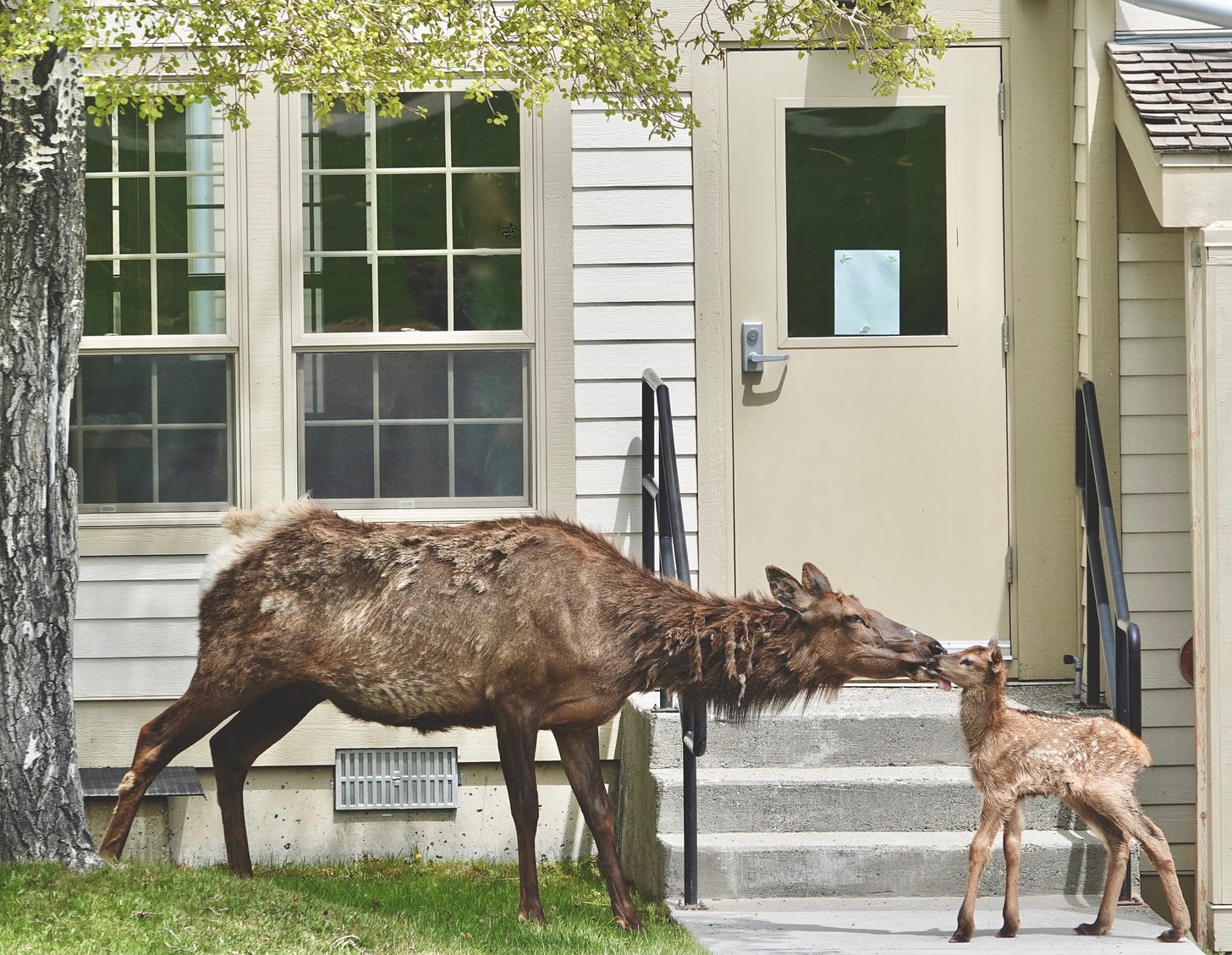One Way Elk Protect Their Calves
Elk use human development as a shield
One spring day, using our car as a blind, Mary and I enjoyed watching this Yellowstone elk and her calf. The calf arose from the sun-warmed concrete beside an administrative building in Mammoth Hot Springs and wobbled on spindly legs. It figured out how to turn around and then lurched forward a few steps to connect with mom, who had been recharging on spring’s new greenery nearby.
While we watched, we didn’t see the mom scanning repeatedly for predators, as elk usually do. Nestled among these Park Service buildings, she had found a safe place for her calf to hide, nurse, and rest for a week or so before the young one must be ready to move with the herd.
Elk know their calves are vulnerable; predators such as bears, wolves, coyotes, and mountain lions take up to two-thirds of each year’s elk calves. Elk have also learned that predators don’t usually hunt around humans and buildings. So some elk mothers. like this one, take refuge in Mammoth Hot Springs. Elk also come to our street and others in Gardiner to give birth and keep their calves safe until the young can run from predators.
Scientists have dubbed this protective behavior “human shielding.” A few years ago researchers studied some elk and pronghorn in nearby Grand Teton National Park to see if they use human shielding. The scientists compared the animals’ behavior near two roads; one road carried thirty times more traffic than the other. The elk and pronghorn near the busier road ate more, relaxed more, and looked around less. The researchers concluded that grazers such as elk and pronghorn use areas with more human development to shield themselves from predators.
While human shielding helps calves avoid predators, the presence of newborns and their protective mothers can be dangerous for residents and visitors. Mammoth-Gardiner has an online community bulletin board where people post all kinds of things, including warnings about wildlife. During one elk calving season, a woman reported that she and a friend were chased by a female elk despite keeping ample distance and a fenced playground between them and the animal.
Her post drew a herd of responses. Two locals who live near the sighting confirmed that the elk was chasing people because she had hidden her newborn nearby. Another person described how elk in his neighborhood have stashed their calves between outbuildings; in flower beds; and under porches, decks, and trucks.
Once, when I innocently stepped out of my garage door and onto the driveway in Gardiner, an elk mother that had been standing across the street charged me without warning. She stopped, thankfully, with her nose about a foot from mine. As I watched her nose flare and listened to her excited breathing, I realized she was probably protecting her calf that was hidden out of sight across the street and down a hill. I spoke softly to her, backed into the garage, closed the garage door, and escaped injury.
So while the sight of a mom and calf can warm your heart and make you want to draw near, don’t do it. These mothers are—as they should be—incredibly protective of their calves. A mother will charge a person that she perceives to be a threat. We can help these mothers and calves by keeping our distance—at least 25 yards—and not becoming that threat.
Thanks for joining me in this Love the Wild.
If you enjoyed this Love the Wild, please spread the joy and share it with others.
If you haven’t yet subscribed, I hope you will. It’s free.
You’ll receive a Love the Wild in your inbox each week. In addition to stories such as this one, you’ll enjoy a variety of podcasts, slideshows, photo essays, commentaries, excerpts from my books and more. With each, I hope to warm your heart and excite your mind as we share moments with wildlife and in wild lands.
Please log in to comment. I love reading and replying to your comments.
I write and photograph to protect wildlife and preserve wild lands.
My bestselling In the Temple of Wolves; its sequel, Deep into Yellowstone; and its prequel, The Wilds of Aging are available signed. My books are also available on Amazon unsigned or as eBook or audiobook.
Image Credits:
Photo of elk and calf by Rick Lamplugh



Loved reading about these elk mothers again. It’s difficult to understand why some people don’t believe that animals are sentient beings. Many “animal” mothers take much better care of their offspring than some humans!
Thanks for this post, Rick. These are wise and real words. I find myself with mixed feelings about human shielding. Regardless of the immediate danger to people, I wonder about the long term prospects for animals who adopt this practice. Are humans inadvertently contributing to an overall decline in the "behavioral health" of the elk and pronghorn? As always, I have only questions and no answers.